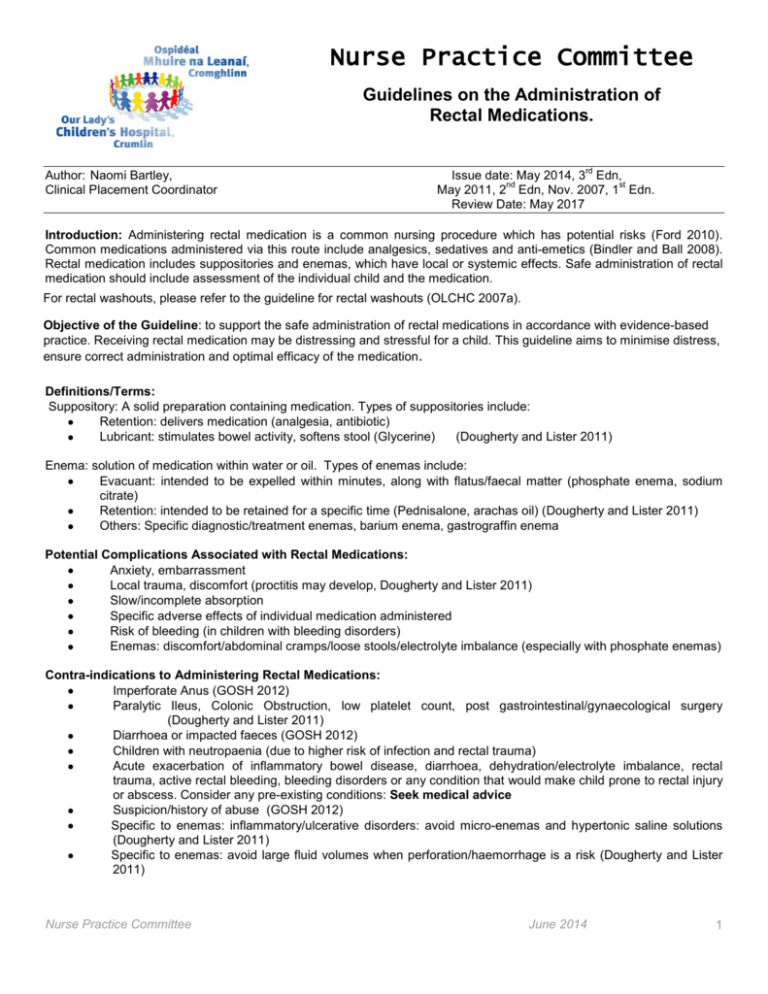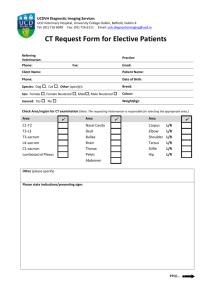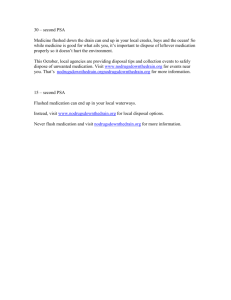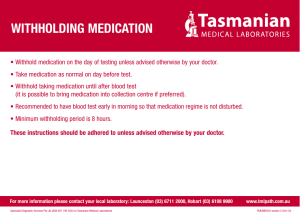
Nurse Practice Committee
Guidelines on the Administration of
Rectal Medications.
Author: Naomi Bartley,
Clinical Placement Coordinator
rd
Issue date: May 2014, 3 Edn,
nd
st
May 2011, 2 Edn, Nov. 2007, 1 Edn.
Review Date: May 2017
Introduction: Administering rectal medication is a common nursing procedure which has potential risks (Ford 2010).
Common medications administered via this route include analgesics, sedatives and anti-emetics (Bindler and Ball 2008).
Rectal medication includes suppositories and enemas, which have local or systemic effects. Safe administration of rectal
medication should include assessment of the individual child and the medication.
For rectal washouts, please refer to the guideline for rectal washouts (OLCHC 2007a).
Objective of the Guideline: to support the safe administration of rectal medications in accordance with evidence-based
practice. Receiving rectal medication may be distressing and stressful for a child. This guideline aims to minimise distress,
ensure correct administration and optimal efficacy of the medication.
Definitions/Terms:
Suppository: A solid preparation containing medication. Types of suppositories include:
•
Retention: delivers medication (analgesia, antibiotic)
•
Lubricant: stimulates bowel activity, softens stool (Glycerine)
(Dougherty and Lister 2011)
Enema: solution of medication within water or oil. Types of enemas include:
•
Evacuant: intended to be expelled within minutes, along with flatus/faecal matter (phosphate enema, sodium
citrate)
•
Retention: intended to be retained for a specific time (Pednisalone, arachas oil) (Dougherty and Lister 2011)
•
Others: Specific diagnostic/treatment enemas, barium enema, gastrograffin enema
Potential Complications Associated with Rectal Medications:
•
Anxiety, embarrassment
•
Local trauma, discomfort (proctitis may develop, Dougherty and Lister 2011)
•
Slow/incomplete absorption
•
Specific adverse effects of individual medication administered
•
Risk of bleeding (in children with bleeding disorders)
•
Enemas: discomfort/abdominal cramps/loose stools/electrolyte imbalance (especially with phosphate enemas)
Contra-indications to Administering Rectal Medications:
•
Imperforate Anus (GOSH 2012)
•
Paralytic Ileus, Colonic Obstruction, low platelet count, post gastrointestinal/gynaecological surgery
(Dougherty and Lister 2011)
•
Diarrhoea or impacted faeces (GOSH 2012)
•
Children with neutropaenia (due to higher risk of infection and rectal trauma)
•
Acute exacerbation of inflammatory bowel disease, diarrhoea, dehydration/electrolyte imbalance, rectal
trauma, active rectal bleeding, bleeding disorders or any condition that would make child prone to rectal injury
or abscess. Consider any pre-existing conditions: Seek medical advice
•
Suspicion/history of abuse (GOSH 2012)
•
Specific to enemas: inflammatory/ulcerative disorders: avoid micro-enemas and hypertonic saline solutions
(Dougherty and Lister 2011)
•
Specific to enemas: avoid large fluid volumes when perforation/haemorrhage is a risk (Dougherty and Lister
2011)
Nurse Practice Committee
June 2014
1
Equipment:
• Rectal Medication
• Child’s chart, prescription sheet
• Non sterile gloves and apron
• Bedpan, toilet or commode (if appropriate)
●Clean Tray
●Disposable incontinence sheet, Tissues/Wipes
●Water-based lubrication gel
●Bravery certificates/stickers for children, if available.
ACTION: Prior to Procedure
Rectal medications must be administered as per OLCHC
nursing policies/guidelines and individual manufacturer’s
instructions. Assess the child’s individual suitability for
rectal administration, (see contra-indications above)
RATIONALE & REFERENCE
To ensure safe administration of medications (OLCHC 2006,
ABA 2007)
Gather equipment required for the procedure
To be adequately prepared
Explain the procedure to the child/family, allow time for
questions. Consider/discuss child/parental preferences.
To improve cooperation and trust (Bartley 2012). In
accordance with local guidelines (OLCHC 2007b)
Ensure privacy for the child
To maintain dignity (OLCHC 2007b)
Encourage child to empty their
administration of rectal medication
bowels
prior
to
To aid absorption of medication (GOSH 2012), avoid
medication being expelled prior to its absorption.
Ensure a bedpan, toilet/commode, nurse call bell is easily
accessible during and after the procedure
Administration of rectal medication may stimulate the need
for the child to defaecate.
Decontaminate hands and apply gloves directly before
procedure. Use ANNT level 3 throughout procedure.
Prevention of cross infection (OLCHC 2011a, OLCHC 2013,
OLCHC 2013a)
Lie the child on their left side with their knees bent and
drawn up towards the abdomen.
To facilitate easy passage into rectum (Dougherty and Lister
2011).
Place incontinence sheet underneath the child’s buttocks
To prevent soiling of the bed linen and embarrassment
(Dougherty and Lister 2011)
Assess anal area for abnormalities. Seek advice prior to
administering medication if abnormalities are detected
To reduce harm (GOSH 2012)
ACTION: Administering Rectal Suppositories
Remove any wrapping, ensure medication is intact
Do not cut suppositories
RATIONALE & REFERENCE
To ensure patient safety
To ensure accurate dosage (Barron and Hollywood 2010)
Lubricate the apex of the suppository with lubrication gel
To ensure easy insertion (Barron and Hollywood 2010).
Ensure suppository is inserted as per manufacture’s
instructions.
Separate the buttocks and insert the suppository into the
child’s rectum, just past the internal sphincter. Insert the
pointed end /apex first (check manufacturer’s instructions)
To ensure the medication is in the correct position (Barron
and Hollywood 2010)
Encourage the child to hold the suppository for 20 mins.
Allows time for medication to act (Dougherty and Lister
2011)
ACTION: Administering a Rectal Enema
Warm enema fluid to room temperature by immersing into a
jug of warm water
Test the temperature of the enema fluid on the forearm
prior to administration
Lubricate the nozzle of the enema/tube with lubrication gel
Squeeze the enema to prime the nozzle/tube
Separate the buttocks and slowly insert the nozzle/tube
RATIONALE & REFERENCE
To prevent mucosal damage (Dougherty and Lister 2011)
Nurse Practice Committee
To ensure patient safety
To prevent mucosal trauma (Dougherty and Lister 2011)
To expel air (GOSH 2012)
The enema needs to pass the anal canal and enter the
June 2014
2
into the anal canal (check manufacturer’s instructions)
rectum (Dougherty and Lister 2011).
Slow and gentle administration will prevent any damage to
the child’s colon (Barron and Hollywood 2010)
If you continue to feel resistance, stop and contact the
medical team for advice
Individual patient assessment is vital
Fig 1: Administration of enema
Retention Enema:
Allow fluid to enter slowly, maintain bedrest with foot of bed
elevated by 45 degrees for the length of time prescribed
To assist in retaining the enema (Dougherty and Lister
2011). (Unless medically contra-indicated)
Evacuant Enema:
Allow fluid to enter slowly by rolling the enema pack from
the bottom of the pack to the top, until the pack is empty.
To prevent backflow (Dougherty and Lister 2011)
Withdraw the nozzle or tubing slowly, continuing to squeeze
the enema
Avoids loss of fluid, prevents backflow into bottle (GOSH
2012)
ACTION: After The Procedure
Encourage the child to retain the medication for 10-20
minutes or as long as possible, prior to emptying bowels
RATIONALE & REFERENCE
To assist effectiveness of the medication (GOSH 2012)
Clean away any lubricating jelly from the peri-anal region
Prevents irritation, ensures comfort (Dougherty and Lister
2011)
Remove gloves and decontaminate hands.
Prevention of cross infection (OLCHC 2011a, OLCHC
2013a)
To ensure the safety of all staff and patients (OLCHC 2011)
Dispose of equipment appropriately.
Ensure the child is reassured and comfortable after the
procedure. Praise the child after the procedure.
Record the administration of medication as per hospital
policy.
Observe the child after the procedure for the effectiveness
of the medication and any adverse effects. If the medication
is expelled immediately post administration or the child
passes a bowel motion, report to medical staff and
document in nursing notes.
Praise provides positive outcomes (Barron and Hollywood
2010). Enemas cause peristalsis and the child may have
abdominal cramps (GOSH 2012).
To reduce the risk of medication errors and support
accountability (ABA 2002).
To evaluate the effects of the medication/procedure (Barron
and Hollywood 2010).
Companion Documents
Our Lady’s Children’s Hospital (2007a) Guidelines on Rectal Washouts for Infants, Our Lady’s Children’s Hospital: Dublin.
Our Lady’s Children’s Hospital (2007b) Prevention of Abuse of Children by a Staff Member While in the Care of the Hospital, Our
Lady’s Children’s Hospital: Dublin.
Our Lady’s Children’s Hospital Crumlin (2006) Oral Medication Guidelines for Nursing Staff, Our Lady’s Hospital for Sick Children,
Dublin.
Implementation Plan
Communication and Dissemination
•
Guidelines will be posted on hospital Intranet
•
Hard copies of the guidelines will be included in the Nurse Practice Guideline Folder/Nursing
Nurse Practice Committee
June 2014
3
REFERENCES
th
Algren C.L. and Arnow D. (2007) Pediatric Variations of Nursing Interventions. In Wongs’ Nursing Care of Infants and Children, 8 edn
(Hockenberry M.J. and Wilson D. Eds.) , Mosby Elsevier, Missouri, 1083-1139.
An Bord Altranais (2002) Recording Clinical Practice. Guidance to Nurses and Midwives, An Bord Altranais, Dublin.
An Bord Altranais (2007) Guidance to Nurses and Midwives on Medication Management, An Bord Altranais, Dublin.
Barron C. and Hollywood E. (2010) Drug administration. In Clinical Skills in Children’s Nursing ( Coyne I, Neill F. and Timmins F., Eds.),
Oxford University Press, Oxford, 147- 181.
Bartley N. (2012) Administration of Rectal Suppositories in Children, World of Irish Nursing, Vol 20, (5),
http://www.inmo.ie/tempDocs/Child%20Health%20PAGE41-42.pdf last accessed 04/04/14.
th
Bindler R.C. and Ball J.W. (2008) Clinical Skills Manual for Pediatric Nursing, 4 Ed., Pearson Prentice Hall, New Jersey.
th
Dougherty L. and Lister S. (2011) The Royal Marsden Hospital Manual of Clinical Nursing Procedures, 8 Edition, Wiley-Blackwell,
Oxford.
Ford L., Maddox C., Moore E. and Sales R. (2010) The safe management of medicines for children. In Practices in Children’s
rd
Nursing: Guidelines for Community and Hospital 3 edn, (Trigg E and Mohammed TA., Eds), Churchill Livingstone,
Edinburgh, pages 45-74.
Great Ormond Street Hospital (2012) Manual of Children’s Nursing practices, Blackwell Publishing, Oxford.
Our Lady’s Children’s Hospital (OLCHC) (2011) OLCHC Safety Statement, OLCHC, Dublin.
Our Lady’s Children’s Hospital (OLCHC) (2011a) Standard Precautions, OLCHC, Dublin
Our Lady’s Children’s Hospital (2007a) Guidelines on Rectal Washouts for Infants, Our Lady’s Children’s Hospital: Dublin.
Our Lady’s Children’s Hospital (2007b) Prevention of Abuse of Children by a Staff Member While in the Care of the Hospital, Our
Lady’s Children’s Hospital: Dublin.
Our Lady’s Children’s Hospital (2013) Aseptic Non-Touch Technique, OLCHC, Dublin.
Our Lady’s Children’s Hospital (2013a) Hand Hygiene Guideline, OLCHC, Dublin
Our Lady’s Children’s Hospital Crumlin (2006) Oral Medication Guidelines for Nursing Staff, Our Lady’s Hospital for Sick Children,
Dublin.
Diagrams:
1
http://health.yahoo.net/search?q1=Enema+Administration&st=photos last accessed 28/04/11
Document Number:
Edition Number:
Number of Copies:
Responsibility for this Document: NPC
Ratified By: Nurse Practice Committee (NPC)
Date of Ratification:
Approved By: Geraldine Regan, Director of Nursing.
Signature: Geraldine Regan
Date of Approval:
© 2014, Our Lady’s Children’s Hospital, Crumlin, Dublin 12. All rights reserved. No part of this publication may be reproduced, stored
in a retrieval system or transmitted in any form or by any means without the prior written permission of the copyright holder. Our Lady’s
Children’s Hospital makes no representation, express or implied, with regard to the accuracy of the information contained in this
publication and cannot accept any legal responsibility for any errors or omissions that may be made.
Nurse Practice Committee
June 2014
4







